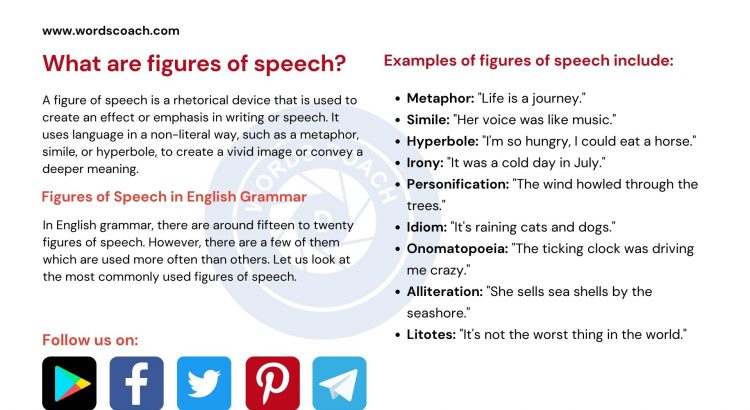A figure of speech is a rhetorical device that is used to create an effect or emphasis in writing or speech. It uses language in a non-literal way, such as a metaphor, simile, or hyperbole, to create a vivid image or convey a deeper meaning.
Definition of a Figure of Speech
A figure of speech, according to the Oxford Learner’s Dictionary, is defined as “a word or phrase used in a different way from its usual meaning in order to create a particular mental picture or effect.” The Cambridge Dictionary defines a figure of speech as “an expression that uses words to mean something different from their ordinary meaning.” According to the Collins Dictionary, a figure of speech is “an expression or word that is used with a metaphorical rather than a literal meaning.”
Figures of Speech in English Grammar
In English grammar, there are around fifteen to twenty figures of speech. However, there are a few of them which are used more often than others. Let us look at the most commonly used figures of speech.
Examples of figures of speech include:
- Simile
- Metaphor
- Personification
- Apostrophe
- Alliteration
- Assonance
- Hyperbole
- Euphemism
- Antithesis
- Oxymoron
- Epigram
- Irony
- Pun
- Metonymy
- Synecdoche
- Metaphor: “Life is a journey.”
- Simile: “Her voice was like music.”
- Hyperbole: “I’m so hungry, I could eat a horse.”
- Irony: “It was a cold day in July.”
- Personification: “The wind howled through the trees.”
- Idiom: “It’s raining cats and dogs.”
- Onomatopoeia: “The ticking clock was driving me crazy.”
- Alliteration: “She sells sea shells by the seashore.”
- Litotes: “It’s not the worst thing in the world.”
Figures of speech are often used to add interest and variety to language, and to make writing more engaging and memorable. They can be used in poetry and literature, but also in everyday conversations and writing.


